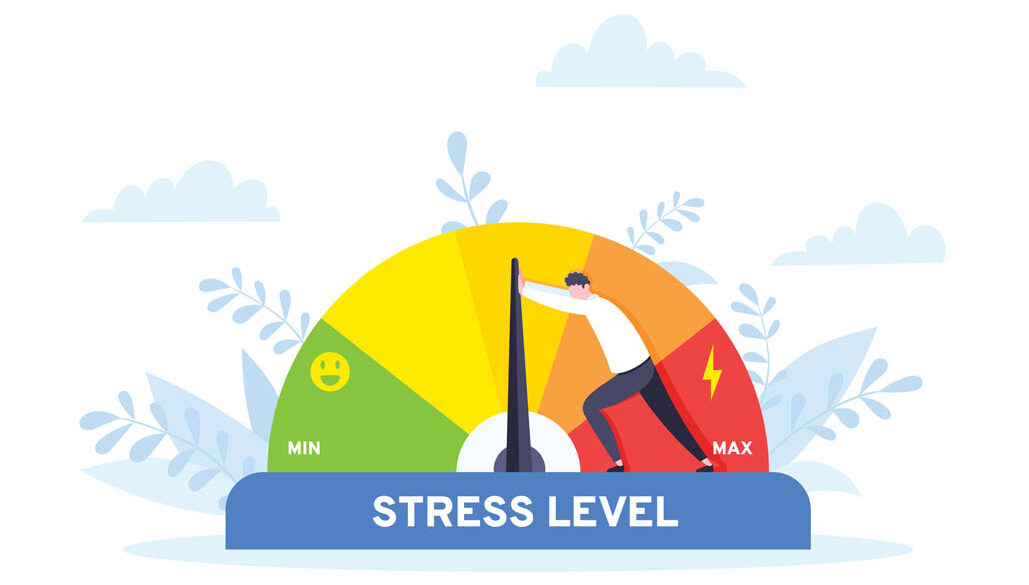Jason has always been a standout employee. Lately, though, he’s shifted into overdrive. He arrives before the crack of dawn, stays until 7 p.m., and gets his projects done three weeks before they’re due.
Every manager’s dream? Maybe. But there’s another possibility: Jason is overcompensating for chronic stress that will eventually lead to a mental breakdown and his departure from the company.
Stories of employee breakdowns are increasingly common in today’s workplace. Some 66% of American employees are experiencing burnout, a common result of stress, according to a new study from Moodle, an online learning technology company. Younger workers seem to be suffering more: Over 81% of survey respondents between 18 and 34 years of age are reporting burnout, much higher than the 49% over 55.
Creating stress
What’s fueling the problem? “Of the many causes of stress in today’s workplace, the one leading the way is economic uncertainty,” said Randy Goruk, president of The Randall Wade Group, Scottsdale, Arizona. “Everybody’s concerned that a general business downturn might lead to staff reductions. On top of that, we have the technology factor: People are afraid AI will replace their positions.”
Such fears are only magnified by incursions of business activity into the domestic sphere. “Recently, there has been less of a distinction between home and work, a trend that started during COVID when many people started operating remotely,” said Brittany L. Truszkowski, chief operating officer, Grand Canyon Law Group. “At the same time, managers are demanding more productivity than ever before and expecting workers to be constantly available.”
Too, domestic life itself has become more complicated. “Workers are facing more challenges at home,” said Joe Mull, a workplace engagement consultant. “Some are economic, while others are related to an increase in mental health issues. And more people are acting as caregivers for family members.” Pressures can mount when people lack the opportunity to de-stress after work.
Spotting stress
Not all stress is bad. Some anxiety is a normal and even productive reaction to workplace challenges. “Healthy stress is a natural response to a new project and can actually motivate people to get things done,” said Samantha Edu, a workplace wellness consultant. “Stress starts to get problematic, though, when it damages peoples’ ability to perform at their peak.”
How to tell the difference? Bad stress often causes a change in employee behavior. In this article’s opening story, Jason’s performance shot through the roof. But performance can also plummet. “Stressed individuals may start missing deadlines,” said Max Friar, managing partner of Calder Capital. “They may exhibit less creative problem-solving or become easily irritated and forgetful. The quality of their work may drop, or they may start arriving late or calling in sick.”
Often, stressed individuals exhibit emotional detachment: This can manifest as a retreat into silence, a withdrawal from team interactions, or lack of interest in outcomes for which they once took pride.
Finally, one system-wide condition is a real red flag: High employee churn. “Organizations that have high chronic turnover, especially if employees jump ship for competing businesses, are often suffering from workplace stress,” said Mull.
Reducing stress
The good news is that companies can take steps to spot and reduce workplace stress. Doing so can bolster profitability. “People who are less stressed are more engaged with their work, incur less absenteeism, and exhibit greater productivity,” said Susan Snipes, head of Remote People, a recruitment firm. “All of that contributes to the bottom line.”
Techniques for stress reduction tend to revolve around one central idea: Employees become happier and more productive when they are treated as people rather than as cogs in a machine. “Managers can go a long way toward reducing stress by introducing more humane practices in the workplace and minimizing the degree to which jobs impact individuals’ domestic lives,” said Mull. Here are some effective techniques:
Listen better
Humanizing the workplace starts with listening. “Go talk with your people and listen to what they say,” said Goruk. “Come up with a couple of great questions you can ask that result in feedback about their greatest concerns. This can help get to the bottom of what’s creating stress.”
Here are a few questions that can elicit useful feedback:
- What can we do to make your job easier?
- How can the work environment be changed to make our business more productive?
- Is there any part of your job that seems unnecessary or requires more time than it’s worth?
- Bonus tip: Some managers maintain open-door policies, making themselves available at specific times when employees can air their feelings in a private setting.
Build trusting relationships
Managers who build trusting relationships with team leaders will be better able to spot signs of stress. They may discover that some people are engaging in too much or too little social interaction, or they may perceive a negative personality conflict among team members.
Managers and supervisors should tell staff members that it’s okay to talk about what is bothering them. Otherwise, they may fear opening up. “People may sense it is inappropriate to talk about emotions at work,” said Snipes. “They may think they will be perceived as weak if they admit they’re stressed.”
Trust can also be built with proactive and transparent communication. “Suppose a rumor about a pending company merger or departmental change is causing everyone to be stressed out,” said Goruk. “Proactive and detailed messaging can dispel fear and ensure everyone knows where
they stand.”
- Bonus tip: Gaps in communication can result when team members differ by age, experience, education, or language. These gaps can cause stress because people are not sure they are communicating effectively.
Set clear work guidelines
“Ambiguity when it comes to job expectations can create stress,” said Snipes. This can be avoided by describing the parameters of each position in easily-grasped words. Focus on outcomes rather than micromanaging processes.
People also need context. How do their assigned tasks fit into the larger company picture? What happens to the results of their labors at the next step in the production process?
“Managers also need to be clear about each employee’s career path,” said Snipes. “Setting realistic goals will avoid situations where people have inflated ideas of their future at the company.”
- Bonus tip: Ask employees if anything is unclear about their job performance parameters.
Give regular feedback
How is Deborah doing? Has she met or exceeded her job requirements? “Managers need to give people assurance that they’re doing a good job,” said Goruk. “Constructive feedback will help people feel better about themselves and the work that they’re doing.” Clear communication about sub-par performance is also essential.
- Bonus tip: Rather than wait for annual performance evaluations, regularly praise employees on their achievements and point out any areas where they can improve.
Eliminate silos
Too often, teams separate themselves from their coworkers by building walls around their private fiefdoms. “Workplace silos can lead to unproductive competition that creates stress,” said Goruk. Silos can be discouraged by a workplace culture that encourages social interaction and collaboration. Social events, outings, and team-building activities can also help.
- Bonus tip: Managers should go on record as denigrating silos and communicate company goals that can be shared by every department.
Introduce workplace flexibility
“Flexibility is one of today’s most requested workplace benefits,” said Mull. “Unfortunately, most of the conversation around flexibility gets relegated to the possibility of working from home, but that’s really just one kind of flexibility. Flexibility is really about giving employees input into some aspect of when, where, and how they work.”
Managers might give employees some influence over their start or end times, or the lengths of their shifts or the days that they work, with whom they work, or how they execute their work product.
- Bonus tip: Run pulse surveys that ask employees what kind of flexibility will make them more productive.
Provide helpful resources
A company can provide resources for employees experiencing stress. These might include employee assistance programs, workplace accommodations, or dedicated break rooms. It can also be useful for employers to offer — and encourage the use of — gym memberships, yoga classes, wellness workshops, and discussion groups.
- Bonus tip: Management can encourage the formation of employee resource groups (ERGs), where people with shared identities, interests, or backgrounds can find emotional support.
Management buy-in
An effective stress reduction program requires buy-in from top management. “There’s a ceiling on what frontline and mid-level managers can accomplish when it comes to reducing stress for employees,” said Mull. “Many stress producers are systemic problems. And only business owners and C-suite leaders have the power to drive change at that level.”
Managers and supervisors at every level are subject to their own stressors. “Dealing productively with workplace stress starts with self-care,” said Edu. “Managers need to ensure they receive the coaching and counseling they need to handle their own stress.”
Managers sometimes become stressed because they feel the business will fall apart without their input. As a result, they hesitate to take vacation time that might leave their company vulnerable. The cure here is to document all processes and procedures so others can fill in the gaps when managers step away.
For managers and employees alike, the creation of a productive work environment requires the reduction of stressors in both the business and domestic spheres. “We’re all trying to be whole healthy human beings,” said Edu. “Creating healthy work environments means creating healthy homes and healthy children and healthy marriages and relationships. It all goes around in a cycle.”

Workplace burnout quiz
Are you providing a stress-free workplace? Are you doing enough to foster a stress-free workplace? Find out by taking this quiz. Give yourself 10 points for each “yes” answer to the questions below. Then total your points.
- Do you counsel employees who exhibit sudden changes in behavior?
- Do you ask questions that can reveal hidden sources of employee stress?
- Do you build trusting relationships with key employees?
- Do you set clear guidelines for employee performance?
- Do you ask employees if anything is unclear about their job expectations?
- Do you give regular feedback to employees?
- Do you focus on outcomes rather than trying to micromanage employees’ work?
- Do employees understand how their work contributes to company goals?
- Do you take steps to eliminate silos?
- Do you introduce workplace flexibility when possible?
What’s your score?
- Over 80: Congratulations! Your company has gone a long way toward reducing workplace stress.
- Between 60 and 80: Additional work is needed.
- Below 60: Take steps now before stress levels start to affect the bottom line.




